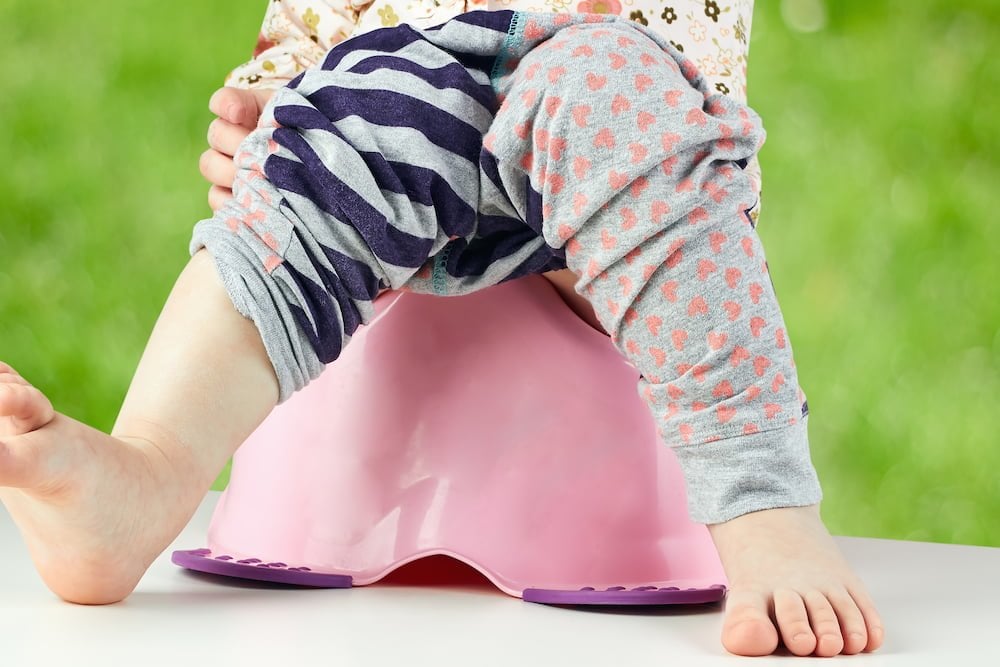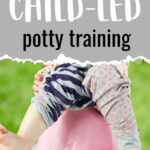No Pressure Potty Training: The Child Led Potty Method That Works
Child led potty training is as simple as it sounds. You follow your child’s cues to tell when they’re ready. This no pressure potty training method may just be the best parenting move you can make.
Gentle potty training can be as natural a learning process as walking, if you create a positive environment. Here you’ll find tips on how to make toilet training as stress-free as possible.
No Pressure Potty Training for the Win
“The simple truth about potty training is that if the child is ready, it happens very easily. If not, a power struggle often ensues — and we all know that no one wins a parent-child power struggle. Fights with your child about his or her body are fights you will never win.”
These wise words from Dr. Laura Markham gave peace of mind to more than a few moms on our team. We all worried that our natural parenting efforts would slip through the cracks in the case of potty training. But when we went at the pace of our little ones, it all worked out without too much of an ordeal.
Let’s get straight to the point. Potty training is nothing to stress over.
If you’ve practiced attachment parenting, you know how successful and worthwhile it is to watch your child’s cues for readiness in every area of development. Toilet training is no different.
“From baby’s viewpoint, toileting is his initiation into ‘bigness’ – a rite of passage from toddlerhood into preschooler-hood. This explains why the desire to stay little makes some procrastinators resist,” according to Dr. Sears’ guide, The Baby Book.
Toilet Training is a Complex Skill
Before you rush baby or toddler to the potty at the first squat, consider what’s involved in learning toileting skills. First, they have to be aware of the pressure sensations of the bowel and bladder. Then they must make the connection between these sensations and what’s happening inside their body.
Next they learn to respond to these urges by running to the potty, where they must know how to remove their pants or diaper, how to situate their body comfortably on this new kind of seat, and how to hold their urges until all systems are go.
With all of these steps, it’s no wonder many babies are still in diapers well into the third year.
Bowel training usually precedes bladder training, mainly because the doughnut muscles surrounding the bowel are not as impatient as those around the bladder. When a baby senses the urge to defecate, they have more time to respond before soiling a diaper. A solid substance is easier to control than liquid.
When the bladder is full, the urge to go is sudden, strong, and hard to control.
The usual sequence of gaining bowel and bladder control is:
1 nighttime bowel control
2 daytime bowel control
3 daytime bladder control
4 nighttime bladder control
It’s helpful to keep these stages in mind so you don’t expect too much from your toddler too soon. The key to gentle potty training is keeping it light, positive, and at a pace that doesn’t overwhelm them.
From Child Led Potty Training to Bathroom Independence
While sticker charts or prizes can be helpful for some kids, the goal is for the child to be self-motivated. External rewards shouldn’t be the main goal. The feeling of accomplishment and independence are what matters more.
Here are some tips for child led potty training with ease.
Know when your child is ready
The first step is to know when to begin potty training. Ask your child if they want to learn to go potty like (mom, dad, their older sibling, etc). Gauge their response. Be understanding and supportive.
Your child will let you know when it’s time. (You could try this between 18-24 months – but every child is different.) Making positive associations with the toilet early on will certainly help.
Be patient
Plan on this taking time – and commit this time to your child. Despite the temptation, don’t force your child to potty train in three days. Many parents need to potty train before sending their child to preschool. If that’s the case, start plenty early so your child doesn’t feel rushed. Failure early on will only set you back and create anxiety around the goal for both of you.
When you are potty training don’t take your phone or create other distractions into the bathroom. Keep objects away from the toilet that could fall in or create unnecessary drama.
Let them sit on the potty or show them how
Show your child how you sit on the toilet to go “potty” and let them sit on the potty seat when they need to go. Kids are natural mimics, and this helps pique their natural curiosity. They might also like to mimic an older sibling or cousin (if everyone consents).
Teach proper technique
Show your child proper wiping techniques – like wiping front to back. For girls, explain she should wipe until she feels dry after “number 1.” And tell her to wipe until it comes out clean after “number two.” If there’s anything in the toilet, always end with a victorious flush.
Set regular potty times
Take your child to the bathroom at regular intervals like when they wake up, after breakfast, before snack, before and after lunch, before you leave the house, etc. Even if they don’t have to go, it will help them move onto a schedule.
And remind them they can go any time they need. Be sure to talk about how it feels to encourage your child to listen to their own body.
Check in
Checking your child’s wiping does not mean you doing the work. You might say, “Let’s check to make sure that you’re done.” For older and more skilled kids, you might ask, “Can you check?” As children get more confident and comfortable, you can give them more privacy to do this on their own.
Wash up properly
Establish good habits now, so they’ll have them when they go to the bathroom independently. Whether or not they actually “go”, always finish your potty routine with a good hand washing. Twenty seconds is a good scrubbing time. And rinse the germs right down the sink with warm water.
Be sure to explain why it’s important to wash their hands after every time they use the potty – or germs could get on anything they touch.
Let your child decide when to switch to underwear
This is a fun part of the child led potty training experience! Your child can choose their own underwear and take the lead. “Don’t rush it, or you’re just asking for accidents,” explains Dr. Laura Markham. “Cleaning up after accidents will frustrate you, and your child will sense that.”
Offer gentle praise
Remember, gentle praise will encourage more cooperation than nagging or threats. Learning this kind of control can be scary for your little one. Panic only causes more accidents. Encouraging words and little rewards for every successful step in the right direction will work wonders.
Don’t stress over accidents
Keep in mind, accidents will happen. When one occurs in clothing, in bed at night, or your child doesn’t quite make it to the toilet in time ask your child what he or she thinks happened.
Ask what they might be able to do to avoid it next time. Children might be scared or forget they weren’t wearing a diaper. Don’t lose your cool. Just try to solve the problem together.
If you had a successful child led potty training experience, share it in the comments. Other parents can certainly benefit from your tips!


